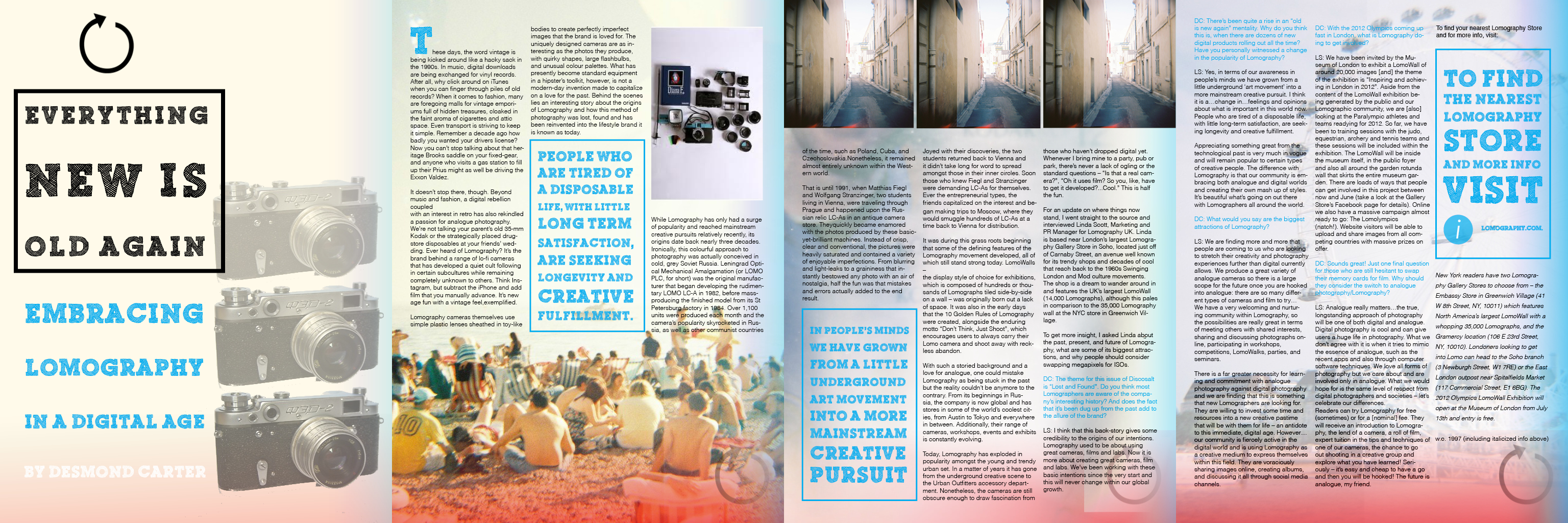Everything New is Old Again: Embracing Lomography in a Digital Age by Desmond Carter
Everything new is old again.
These days, the word vintage is being kicked around like a hacky sack in the 1990s. In music, digital downloads are being exchanged for vinyl records. After all, why click around on iTunes when you can finger through piles of old records? When it comes to fashion, many are foregoing malls for vintage emporiums full of hidden treasures, cloaked in the faint aroma of cigarettes and attic space. Even transport is striving to keep it simple. Remember a decade ago how badly you wanted your drivers license? Now you can’t stop talking about that heritage Brooks saddle on your fixed-gear, and anyone who visits a gas station to fill up their Prius might as well be driving the Exxon Valdez.
It doesn’t stop there, though. Beyond music and fashion, a digital rebellion coupled with an interest in retro has also rekindled a passion for analogue photography. We’re not talking your parent’s old 35-mm Kodak or the strategically placed drug-store disposables at your friends’ wedding. Ever heard of Lomography? It’s the brand behind a range of lo-fi cameras that has developed a quiet cult following in certain subcultures while remaining completely unknown to others. Think Instagram, but subtract the iPhone and add film that you manually advance. It’s new age fun with a vintage feel, exemplified.
Lomography cameras themselves use simple plastic lenses sheathed in toy-like bodies to create perfectly imperfect images that the brand is loved for. The uniquely designed cameras are as interesting as the photos they produce, with quirky shapes, large flashbulbs, and unusual colour palettes. What has presently become standard equipment in a hipster’s toolkit, however, is not a modern-day invention made to capitalize on a love for the past. Behind the scenes lies an interesting story about the origins of Lomography and how this method of photography was lost, found and has been reinvented into the lifestyle brand it is known as today.
While Lomography has only had a surge of popularity and reached mainstream creative pursuits relatively recently, its origins date back nearly three decades. Ironically, this colourful approach to photography was actually conceived in cold, grey Soviet Russia. Leningrad Optical Mechanical Amalgamation (or LOMO PLC, for short) was the original manufacturer that began developing the rudimentary LOMO LC-A in 1982, before mass-producing the finished model from its St Petersburg factory in 1984. Over 1,100 units were produced each month and the camera’s popularity skyrocketed in Russia, as well as other communist countries of the time, such as Poland, Cuba, and Czechoslovakia. Nonetheless, it remained almost entirely unknown within the Western world.
That is until 1991, when Matthias Fiegl and Wolfgang Stranzinger, two students living in Vienna, were traveling through Prague and happened upon the Russian relic LC-As in an antique camera store. They quickly became enamored with the photos produced by these basic-yet-brilliant machines. Instead of crisp, clear and conventional, the pictures were heavily saturated and contained a variety of enjoyable imperfections. From blurring and light-leaks to a graininess that instantly bestowed any photo with an air of nostalgia, half the fun was that mistakes and errors actually added to the end result.
Joyed with their discoveries, the two students returned back to Vienna and it didn’t take long for word to spread amongst those in their inner circles. Soon those who knew Fiegl and Stranzinger were demanding LC-As for themselves. Ever the entrepreneurial types, the friends capitalized on the interest and began making trips to Moscow, where they would smuggle hundreds of LC-As at a time back to Vienna for distribution.
It was during this grass roots beginning that some of the defining features of the Lomography movement developed, all of which still stand strong today. LomoWalls – the display style of choice for exhibitions, which is composed of hundreds or thousands of Lomographs tiled side-by-side on a wall – was originally born out a lack of space. It was also in the early days that the 10 Golden Rules of Lomography were created, alongside the enduring motto “Don’t Think, Just Shoot”, which encourages users to always carry their Lomo camera and shoot away with reckless abandon.
With such a storied background and a love for analogue, one could mistake Lomography as being stuck in the past but the reality couldn’t be anymore to the contrary. From its beginnings in Russia, the company is now global and has stores in some of the world’s coolest cities, from Austin to Tokyo and everywhere in between. Additionally, their range of cameras, workshops, events and exhibits is constantly evolving.
Today, Lomography has exploded in popularity amongst the young and trendy urban set. In a matter of years it has gone from the underground creative scene to the Urban Outfitters accessory department. Nonetheless, the cameras are still obscure enough to draw fascination from those who haven’t dropped digital yet. Whenever I bring mine to a party, pub or park, there’s never a lack of ogling or the standard questions – “Is that a real camera?”, “Oh it uses film? So you, like, have to get it developed?..Cool.” This is half the fun.
For an update on where things now stand, I went straight to the source and interviewed Linda Scott, Marketing and PR Manager for Lomography UK. Linda is based near London’s largest Lomography Gallery Store in Soho, located just off of Carnaby Street, an avenue well known for its trendy shops and decades of cool that reach back to the 1960s Swinging London and Mod culture movements. The shop is a dream to wander around in and features the UK’s largest LomoWall (14,000 Lomographs), although this pales in comparison to the 35,000 Lomography wall at the NYC store in Greenwich Village.
To get more insight, I asked Linda about the past, present, and future of Lomography, what are some of its biggest attractions, and why people should consider swapping megapixels for ISOs.
DISCOSALT: The theme for this issue of Discosalt is “Lost and Found”. Do you think most Lomographers are aware of the company’s interesting history? And does the fact that it’s been dug up from the past add to the allure of the brand?
LINDA SCOTT: I think that this back-story gives some credibility to the origins of our intentions. Lomography used to be about using great cameras, films and labs. Now it is more about creating great cameras, film and labs. We’ve been working with these basic intentions since the very start and this will never change within our global growth.
D: There’s been quite a rise in an “old is new again” mentality. Why do you think this is, when there are dozens of new digital products rolling out all the time? Have you personally witnessed a change in the popularity of Lomography?
LS: Yes, in terms of our awareness in people’s minds we have grown from a little underground ‘art movement’ into a more mainstream creative pursuit. I think it is a change in feelings and opinions about what is important in this world now. People who are tired of a disposable life, with little long-term satisfaction, are seeking longevity and creative fulfillment.
Appreciating something great from the technological past is very much in vogue and will remain popular to certain types of creative people. The difference with Lomography is that our community is embracing both analogue and digital worlds and creating their own mash up of styles. It’s beautiful what’s going on out there with Lomographers all around the world.
D: What would you say are the biggest attractions of Lomography?
LS: We are finding more and more that people are coming to us who are looking to stretch their creativity and photography experiences further than digital currently allows. We produce a great variety of analogue cameras so there is a large scope for the future once you are hooked into analogue: there are so many different types of cameras and film to try. We have a very welcoming and nurturing community within Lomography, so the possibilities are really great in terms of meeting others with shared interests, sharing and discussing photographs online, participating in workshops, competitions, LomoWalks, parties, and seminars.
There is a far greater necessity for learning and commitment with analogue photography against digital photography and we are finding that this is something that new Lomographers are looking for. They are willing to invest some time and resources into a new creative pastime that will be with them for life – an antidote to this immediate, digital age. However, our community is fiercely active in the digital world and is using Lomography as a creative medium to express themselves within this field. They are voraciously sharing images online, creating albums, and discussing it all through social media channels.
D: With the 2012 Olympics coming up fast in London, what is Lomography doing to get involved?
LS: We have been invited by the Museum of London to exhibit a LomoWall of around 20,000 images [and] the theme of the exhibition is “Inspiring and achieving in London in 2012”. Aside from the content of the LomoWall exhibition being generated by the public and our Lomographic community, we are [also] looking at the Paralympic athletes and teams readying for 2012. So far, we have been to training sessions with the judo, equestrian, archery and tennis teams and these sessions will be included within the exhibition. The LomoWall will be inside the museum itself, in the public foyer and also all around the garden rotunda wall that skirts the entire museum garden. There are
loads of ways that people can get involved in this project between now and June (take a look at the Gallery Store’s Facebook page for details).

